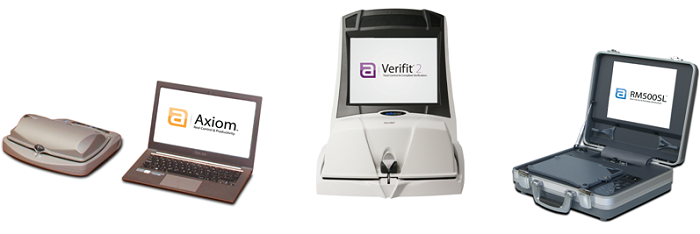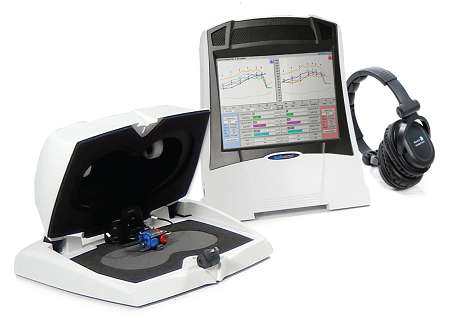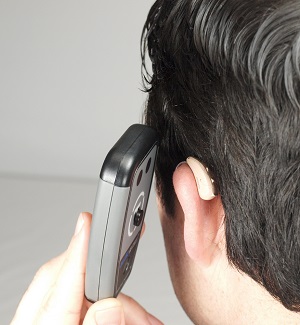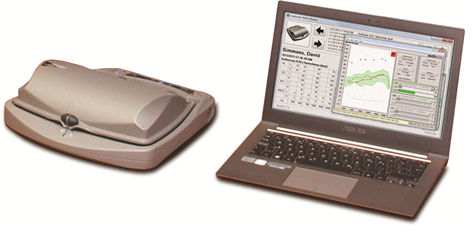New Audioscan Software Supports the Latest RECD Changes, New Frequency Lowering Verification Signals, Binaural Phone Streaming Tests, and More
Carolyn Smaka: John, welcome and thanks for your time today. Tell me about Audioscan’s latest software update. What’s new with the current version?

John Pumford: We’re quite excited about this update. As you know, software updates are free at Audioscan, as we want to ensure that clinicians have the latest features at no additional charge to meet their fitting needs as new technologies are developed.
One of the important new enhancements in our latest software version is related to the RECD (real-ear to coupler difference) measurement procedure, and applies to Verifit 2, Verifit, Axiom and the RM500SL devices. These enhancements were developed in collaboration with the team at the National Centre for Audiology (NCA) at Western University in Canada. We’ve developed revisions to the RECD measurement protocol to support the full matrix of clinical protocols being used, as well as to integrate recently published ANSI S3.46-2013 guidance on the RECD measurement procedure.
For professionals who use RECDs, our website includes documentation and a video that details the changes. We also offer an online CEU webinar with NCA’s Dr. Susan Scollie to support clinicians and provide additional information on the RECD measurement procedure - you can access the webinar here.

Carolyn: It’s great to know that additional support is available. What other enhancements will professionals find in the new Audioscan software?
John: Another key improvement in this software release is the addition of new stimuli for the Verifit 2 system, for use with devices that have frequency lowering technology. Audioscan systems have provided unique test signals for the fitting and verification of frequency lowering technologies for many years, that help clinicians objectively assess the impact of this feature and inform programming and fine tuning decisions. These new signals aren’t meant to replace current verification protocols with conventional hearing aids, but rather to supplement the verification procedures for systems offering frequency lowering.

The new /s/ and /sh/ test signals support recent frequency lowering verification protocols as prescribed by the National Centre for Audiology. They’re based on research indicating that these high frequency narrow band signals offer additional value when trying to fit and verify frequency lowering amplification.
As with all other tests on our systems, clinicians can also use the binaural headphones to supplement the visual fitting display and conduct listening checks. For frequency lowering, this allows you to evaluate the impact of programming on sound quality, and determine if there is audible distinction between the /s/ and /sh/ sounds.
There are specific protocols in place regarding how to use these test signals that are available with the latest software update in our interactive Help system. Additional information can be found in existing and upcoming publications from the NCA and other researchers.
Carolyn: We also have an AudiologyOnline article on the topic. I see the new software supports verification of phone behavior with hearing aids.
John: Yes! As you know, listening on the phone is a concern for many people with hearing loss and unfortunately is often an overlooked and under-verified listening scenario. Our systems provide multiple methods to evaluate phone performance, not only for quality control purposes (for example, via the various ANSI tests that are available), but also to guide the setting of phone program features in hearing instruments.


With the latest software we’re introducing a new accessory, the teletest handset for Verifit 2. This device offers the ability to confirm that the phone program is being automatically activated for hearing aids with autocoil or easy-T programs. Audibility for t-coil inputs can also be checked, not to mention telephone streaming behavior for hearing aids with wireless streaming. An evaluation can be made both onscreen and by listening to hearing aid behavior using the Verifit 2 binaural headphones.
Carolyn: So I can hear if telephone streaming is occurring, and see it onscreen?
John: Yes, the teletest handset is designed to simulate a telephone receiver and is simply placed next to the hearing aid as you would when using the phone. It generates an electromagnetic signal that can be used to assess the performance of telecoil programs.
You can also test binaural phone behavior. Simultaneous binaural measurement capabilities are available in the text box or on the ear with the Verifit 2 when using the teleset handset, so you can quickly evaluate the performance of phone programs designed to stream a signal from the phone ear to the non-phone ear. It’s really exciting to see and provides information that can be quite helpful in the programming and counseling process.
The teletest handset is available free of charge for Verifit 2 users who were not provided one initially. Just visit our website and complete the request form to obtain one.
Protocols for using our phone verification features, including the teletest handset, can be found in the Help section of the software.
Carolyn: Does Audioscan equipment support networking?
John: Definitely. The new software update provides improvements in the networking process that simplifies and streamlines the automatic connection process and supports various office networking environments with the Verifit 2, Verifit, Axiom and RM500SL.

We know that clinicians are very busy. We aim to develop systems and features that can streamline the fitting process and that allow efficient integration into the modern dispensing practice. This concept is represented in the various configuration and layout options we offer, along with other available features such as our NOAH module and Remote Operation capabilities. The Remote Operation capabilities can even support “on-top mode” and telehealth applications.
To further support office integration, the latest software version also offers expanded HP printer support on Verifit 2 and Axiom.
Readers interested in learning more about the various office integration and efficiency options found in Audioscan systems could also review our webinar or text course on this topic.
Carolyn: Are there any other key enhancements you’d like to mention?
John: We now offer additional user interface languages to support our customers around the world. You can now select German, Portuguese, French and Spanish on Verifit 2 and Axiom, and we’ll be adding more languages in future updates.
Our download site has the full list of what's new.
Carolyn: Sounds great. How do professionals obtain the latest Audioscan software update?
John: They simply visit our website and follow an easy download procedure. It only takes a few minutes to keep the fitting systems current, and as I mentioned earlier, it's free of charge.
Carolyn: That’s a lot of news. How can professionals keep current on fitting and verification issues?
John: We offer a number of online and in-person educational opportunities for professionals. Education for the hearing healthcare community has been a core value of the company since it began and continues to be a focus. In fact, my role involves working with our team to develop educational offerings to address the issues and questions affecting today’s fitting professionals.
For instance, on AudiologyOnline, we offer courses on the use of Speechmap, RECD, assessment of directional microphone technology along with the efficient integration of our systems into the modern fitting practice - and we are in the process of adding even more content. Browse our AudiologyOnline courses here.
Audioscan also continues to offer in-person workshops and training opportunities. This year we’ve had a number of workshops and seminars on fitting and verification topics that have had high attendance and have been well received. There are also additional opportunities in various locations for the rest of this year, and we plan on having more next year. Professionals can visit https://audioscan.com/workshops for listings, contact their local representative or contact Audioscan directly for more details.
On our website, we also have short, educational videos on measurement of the RECD, device coupling, and other topics, and we’re in the process of adding even more videos.
Of course, the new enhancements we discussed today are all outlined in the context-sensitive Help system on the Audioscan equipment, as well as in the user manuals. Further questions can also be directed to our customer support or application specialists.
Carolyn: Thanks again, John, for the details on the latest Audioscan software. Professionals seeking more information can follow the links in this interview, or visit www.audioscan.com.
John: Thank you, Carolyn.


